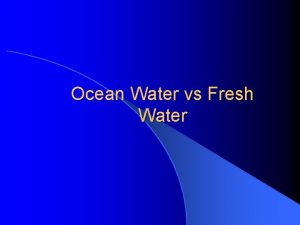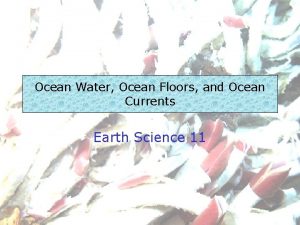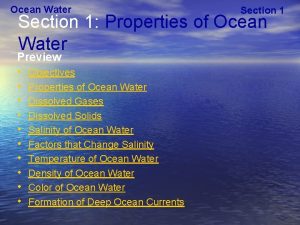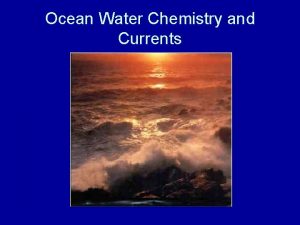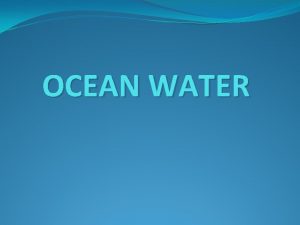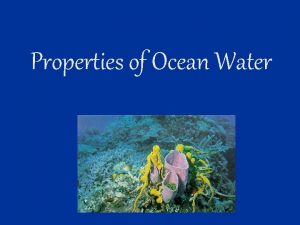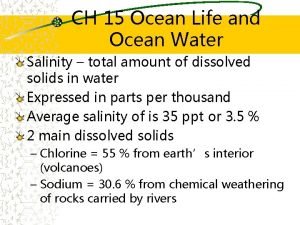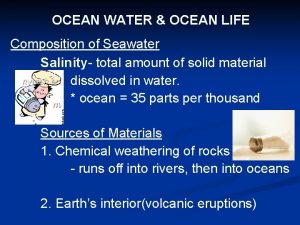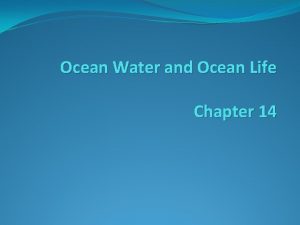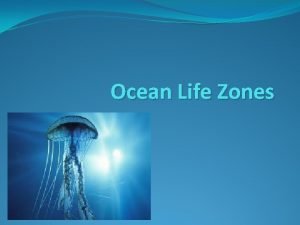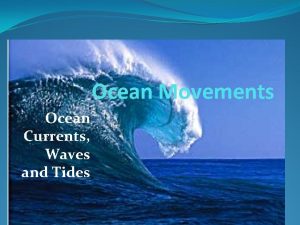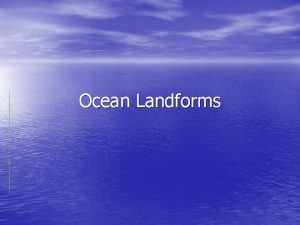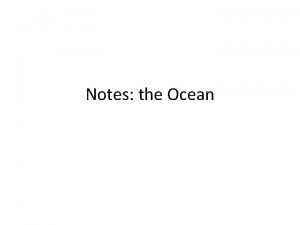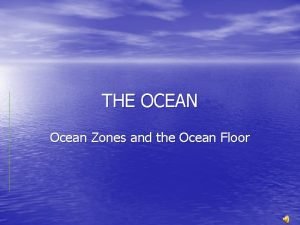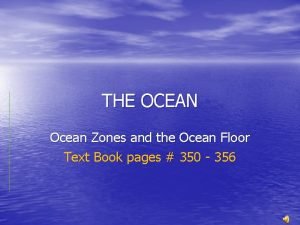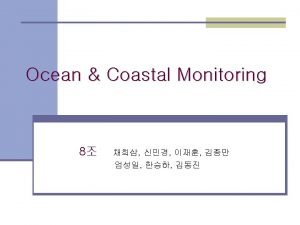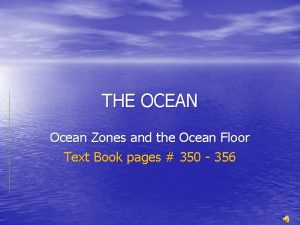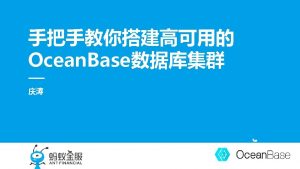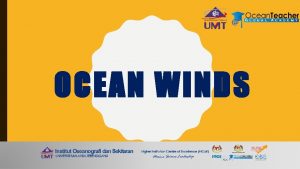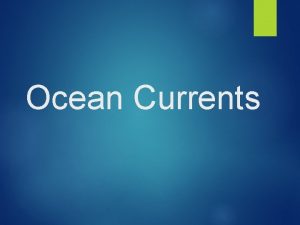Ocean Water Life Ocean Water Life The Ocean






























- Slides: 30

Ocean Water & Life

Ocean Water & Life • The Ocean Floor • Composition of Seawater • Ocean Temperature & Density Variation

PSCI 131: Ocean Water & Life Review • What are these features called? • What happens at these locations? B A Mid-Ocean Ridge (Seafloor spreading) New ocean crust is formed Trench (Subduction Zone) Old ocean crust is destroyed

PSCI 131: Ocean Water & Life The Ocean Floor

PSCI 131: Ocean Water & Life Ocean Life and Ocean Features Certain types of ocean life flourish in different ocean features. Hydrothermal vents (deep sea) Continental Shelf (shallow water)

PSCI 131: Ocean Water & Life Composition of Seawater

PSCI 131: Ocean Water & Life Composition of Average Seawater Salinity – total amount of solid material dissolved in water Ratio of the mass of dissolved substances to the mass of the water sample. per mille (per thousand)

PSCI 131: Ocean Water & Life Composition of Normal Seawater • Salt sources Minerals from the continents Undersea volcanism

Questions • Where do icebergs originate? • If the iceberg melted, would the water be fresh or salty? • If icebergs melt, do you think ocean surface salinity is affected? If so, how?

PSCI 131: Ocean Water & Life Processes Affecting Salinity • Total mass of salt in open oceans doesn’t change, but salinity does • Since salinity = mass of salt / mass of water • So, water must be added/removed for salinity to change

PSCI 131: Ocean Water & Life Processes Affecting Salinity • Salinity increases if water is removed – Evaporation – Sea ice formation

PSCI 131: Ocean Water & Life Processes Affecting Salinity • Salinity decreases if water is added – Precipitation – Runoff (rivers) – Sea ice melting – Icebergs melting

PSCI 131: Ocean Water & Life Global Salinity Variation • Salinity varies by latitude • Areas that have high evaporation rates = high salinities (around 30 degrees N or S)

Think Pair Share • Name two acids. – What happens to a material when it touches an acid? • Name two bases. – What happens to a material when it touches a base?

Ocean Acidity • Rising CO 2 in atmosphere impact chemistry of ocean – About 1/3 of humangenerated CO 2 ends up dissolved in ocean – p. H drops, seawater becomes more acidic • Impacts on ocean life: – Microbes and corals have trouble building hard parts from Ca. CO 3 because acidic water dissolves Ca. CO 3

PSCI 131: Ocean Water & Life Ocean Temperature and Density Variations

Temperature and Density • Ocean Temperature and Density influence: – Deep-ocean circulation – Distribution and types of life • Both vary with depth

What happens to the temperature of the ocean as you go deeper in the water?

Temperature • Surface water is heated by the Sun – Usually warmer than deeper water • Due to varying amount of solar radiation at various latitudes, surface water can be warmer/cooler. – Low latitudes • High temperature at surface • Rapid decrease in temperature with depth (thermocline) – High latitudes • Cooler surface temperatures • No rapid change in temperature with depth

PSCI 131: Ocean Water & Life Temperature vs Depth Warm latitudes Cold latitudes

PSCI 131: Ocean Water & Life Thermocline • Exists between about 300 -1000 m of depth – (Below 1000 m temperature remains relatively constant all the way to the ocean floor. ) • Rapid decrease in water temperature with increasing depth • Exists year-round in tropics/subtropics • Never appears in subpolar/polar latitudes • Seasonal in temperate latitudes

What is density?

PSCI 131: Ocean Water & Life Ocean Water Density • Density = mass per unit volume – “How heavy something is for its size” • Determines water’s vertical position in ocean • Controlled by temperature and salinity (thermohaline) – Higher temp = lower density (expanding water) – Higher salinity = higher density • Temperature has the greater influence – Only in polar climates where temp is relatively constant does salinity significantly affect density

Variation by latitude • Low-latitudes – Low density at the surface – Density increases rapidly with depth (pycnocline) because of colder water • High-latitudes • High-density (cold) water at the surface • Little change in density with depth

PSCI 131: Ocean Water & Life Density vs Depth Warm latitudes Cold latitudes

PSCI 131: Ocean Water & Life Pycnocline • Exists between 300 -1000 m • Rapid increase in water density with increasing depth • Mirror image of thermocline – Temperature has stronger influence on density than salinity • Gravity prevents higher-density water from rising spontaneously and mixing with overlying less dense water – Barrier to mixing between surface and deep water

PSCI 131: Ocean Water & Life Ocean Water Layering • In regions where a thermocline is present – Surface mixed zone: warm, well-circulated • Mixed by waves as well as turbulence from currents/tides • Thickness and temp of this zone will vary due to latitude (thicker near equator)

PSCI 131: Ocean Water & Life Ocean Water Layering • In regions where a thermocline is present – Transition zone: • Location of thermocline and pycnocline

PSCI 131: Ocean Water & Life Ocean Water Layering • In regions where a thermocline is present – Deep zone: • Sunlight never reaches • Water temperatures are just a few degrees above freezing • Water density remains high and constant

PSCI 131: Ocean Water & Life Ocean Water Layering • If no thermocline, then no layering – Polar, subpolar, temperate (in winter)
 Nekton include all animals that
Nekton include all animals that Water and water and water water
Water and water and water water Divergent vs convergent boundaries
Divergent vs convergent boundaries Ocean ocean convergent boundary
Ocean ocean convergent boundary Convergent boundary
Convergent boundary Ocean ocean convergent boundary
Ocean ocean convergent boundary Scrat s continental crack up
Scrat s continental crack up Convergent oceanic oceanic plate boundary
Convergent oceanic oceanic plate boundary Blue ocean strategi
Blue ocean strategi Hát kết hợp bộ gõ cơ thể
Hát kết hợp bộ gõ cơ thể Ng-html
Ng-html Bổ thể
Bổ thể Tỉ lệ cơ thể trẻ em
Tỉ lệ cơ thể trẻ em Gấu đi như thế nào
Gấu đi như thế nào Tư thế worms-breton
Tư thế worms-breton Hát lên người ơi alleluia
Hát lên người ơi alleluia Các môn thể thao bắt đầu bằng tiếng nhảy
Các môn thể thao bắt đầu bằng tiếng nhảy Thế nào là hệ số cao nhất
Thế nào là hệ số cao nhất Các châu lục và đại dương trên thế giới
Các châu lục và đại dương trên thế giới Công thức tính độ biến thiên đông lượng
Công thức tính độ biến thiên đông lượng Trời xanh đây là của chúng ta thể thơ
Trời xanh đây là của chúng ta thể thơ Cách giải mật thư tọa độ
Cách giải mật thư tọa độ 101012 bằng
101012 bằng độ dài liên kết
độ dài liên kết Các châu lục và đại dương trên thế giới
Các châu lục và đại dương trên thế giới Thơ thất ngôn tứ tuyệt đường luật
Thơ thất ngôn tứ tuyệt đường luật Quá trình desamine hóa có thể tạo ra
Quá trình desamine hóa có thể tạo ra Một số thể thơ truyền thống
Một số thể thơ truyền thống Bàn tay mà dây bẩn
Bàn tay mà dây bẩn Vẽ hình chiếu vuông góc của vật thể sau
Vẽ hình chiếu vuông góc của vật thể sau Thế nào là sự mỏi cơ
Thế nào là sự mỏi cơ
































